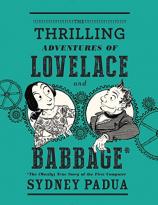The Thrilling Adventures of Lovelace and Babbage
Review
The Thrilling Adventures of Lovelace and Babbage
THE THRILLING ADVENTURES OF LOVELACE AND BABBAGE is the quirky debut graphic novel by animator and story artist Sydney Padua. It follows the lives of 19th-Century English scientist Charles Babbage and Ada, Countess of Lovelace: the man who designed the first programmable computer and the woman who designed the first computer programs. In the real world, Babbage never builds his computer (called the Analytical Engine) and Lovelace dies of uterine cancer at the age of thirty-six. Padua doesn't like this, so she changes the endings of their stories. Instead of dying with only plans and no product, Padua creates a “pocket universe” where Lovelace and Babbage are still alive, the Analytical Engine is built and they use it to go on thrilling adventures.
The first chapter is strictly historical. It explains how Lovelace is the daughter of Lord Byron alongside speculation as to why she is such a math whiz, while portraying Babbage as the eccentric scientist who keeps abandoning one project to work on a better, more efficient one. He hates street musicians, she hates poetry. But in the second chapter, readers are introduced to the “pocket universe.” Even though the adventures Lovelace and Babbage embark on throughout the rest of the book did not happen, Padua adds countless footnotes to explain what really did --- so even though we are in a fictional world, we keep learning throughout the entire novel.
"I never cared about computer science or the history of it, but this book made me eager to dig through every footnote to learn more and more."
In fact, there are almost more footnotes in LOVELACE AND BABBAGE than there are comics. This means the book can get wordy at times, but it is a clever play off of Lovelace's legacy: she was known for translating a French explanation of the Analytical Engine and adding her own footnotes that were longer than the explanation itself. Sometimes Padua's footnotes can feel irrelevant, like they are there just there so there’s a footnote on almost every page, and many times they explain a joke made by Lovelace or Babbage that can only be understood if you know historical computer science and programming. But for the most part, they're informative and funny, because they're laced with Padua's voice and opinions --- so even though they take away from the main comic, it's almost never an issue.
Another thing the footnotes do is make clear exactly how much passion and work Padua poured onto this book. She describes actions as “so Lovelace” and cites tiny snippets from obscure newspaper clippings about her heroes. She includes an entire debate about whether or not Lovelace was really the first computer programmer --- and if she actually invented the Analytical Engine herself, or if she was just used by Babbage to be a face for the mathematics. That level of enthusiasm makes it easy, and inevitable, to care about the characters and find their stories, real or fake, incredibly interesting just because the writer does. I never cared about computer science or the history of it, but this book made me eager to dig through every footnote to learn more and more.
The jokes are corny at times, and many need to be explained in footnotes, but since the main characters are scientists who don't exactly know how to get along in society, this only adds to the story. What also adds to it are the cartoons themselves, which make the characters look quirky and a little whimsical. It's supposed to be a book that's easy to laugh with because it's full of antics by mad scientists, so having cartoon characters really emphasizes that. But even though the drawings are fun, Padua has an amazing attention for detail: she attempts to draw graphs and charts of what an Analytical Engine would look like, had it ever been built, and some of the drawings were taken only from descriptions instead of existing graphs (because there were none). She meticulously drew every part of the giant machine, complete with labels and the most simplistic explanations science would allow. I still had trouble totally understanding how it worked, but she was able to give enough of a foundation that following the story wasn't hard. And she added Lovelace and Babbage trying to work on the computer in most of her diagrams, so the humor wasn't lost.
This book is more of a series of vignettes --- each chapter is a funny story about Lovelace and Babbage dealing with the Analytical Engine and dealing with people dealing with the Analytical Engine. Because there isn't a central plot it feels like it ends abruptly, but it won't if you go into it knowing that this book is made for readers to laugh and learn about some of history's most overlooked scientists.
Reviewed by Jess Costello on April 21, 2015
The Thrilling Adventures of Lovelace and Babbage
- Publication Date: April 21, 2015
- Genres: Comic Books, Fiction, Graphic Novel, Historical Fiction
- Hardcover: 320 pages
- Publisher: Pantheon
- ISBN-10: 0307908275
- ISBN-13: 9780307908278











